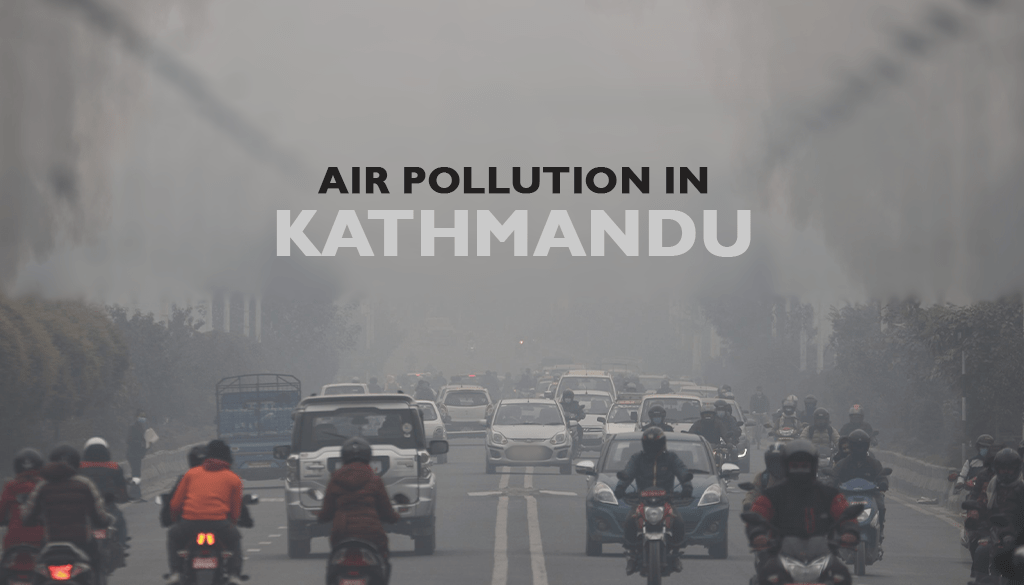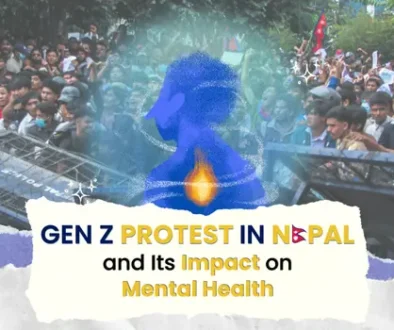Air Pollution in Kathmandu, Nepal: Updated Information

Last updated on April 17th, 2025 at 02:44 pm
Kathmandu has been facing severe air pollution in recent years. It has frequently ranked among the most polluted cities globally, with pollution reaching hazardous levels, especially during the dry season. This rising pollution poses significant challenges to public health and the environment. So, everyone must be aware of this situation and take preventive measures to be safe.
Hence, this article will dive into ongoing air pollution in Kathmandu, its causes, health impacts, and possible solutions to mitigate this growing environmental and public health crisis.
Key Takeaways:
- Kathmandu’s air pollution hits high levels, with PM2.5 at 384 µg/m³ in 2025, far above the WHO’s safe limit of 15 µg/m³, making it one of the world’s most polluted cities.
- Vehicle emissions, wildfires, brick kilns, construction dust, and waste burning cause most pollution, which is worsened by city growth and cross-border smog.
- Pollution causes breathing problems like asthma, heart issues, skin allergies, and eye irritation.
- The 2020 Air Quality Plan fights pollution with Euro-IV standards, electric vehicles, green waste management, new roads, cycle lanes, and flyovers.
- Stay safe by getting a lung test (PFT) at health care centers like Clinic One, checking air quality, wearing N95 masks, keeping indoor air clean, and using fewer personal vehicles.
Current Status of Air Pollution in Kathmandu
As of April 2025, Kathmandu’s air quality remains poor despite recent rainfall. On April 13, PM2.5 levels reached 39 μg/m³ and PM10 at 75 µg/m³ in some areas, exceeding the World Health Organisation’s (WHO) safe limit of 15 μg/m³.
While rain since April 9 (Wednesday) has provided minor relief by settling dust and reducing short-term particulate matter, pollution still remains high due to leftover smoke from wildfire and vehicle emissions.
Earlier this year, the AQI reached a hazardous 384 μg/m³, making Kathmandu the most polluted city globally. This rise in pollution has been attributed to widespread wildfires and prolonged dry conditions.
While writing this article, the air pollution in Kathmandu remains at PM2.5, i.e, fine particles (≤ 2.5 µm) at 58.3 µg/m³ and PM10, i.e, coarse particles (≤ 10 µm) at 179.9 µg/m³, which is still unhealthy. To see live updates on Kathmandu’s air pollution, you can visit different websites like IQAir.
Past 10-Year Air Quality Index of Kathmandu
According to The Kathmandupost, in 2024, Kathmandu was already regarded as the world’s most polluted city. Over the past decade, this capital city has faced significant air quality challenges.
Between 2015 and 2019, the average PM2.5 concentrations were around 48 µg/m³, exceeding the WHO-recommended 15 µg/m³ limit. However, pollution spiked in subsequent years, particularly during the dry months of March to May.
In early 2021, forest fires caused PM2.5 levels to peak at hazardous levels, with maximum hourly averages reaching 371 µg/m³. By November 2023, the same soared to 154 µg/m³, ranking Kathmandu as the seventh most polluted city globally.
In April 2024, the Air Quality Index (AQI) hit 192, placing the city in the ‘Unhealthy’ category. Similarly, in 2025, the situation worsened, with PM2.5 levels reaching the highest record of 384 µg/m³, due to extensive wildfires and stagnant atmospheric conditions.
Major Causes of Air Pollution in Kathmandu Valley
Several factors make air quality worse in the valley. However, the study conducted by K4DD found that the primary causes include urbanisation, brick kilns, vehicular emissions, and transboundary pollution. Other causes, such as industrial activities, wildfires, crop burning, and waste burning, also contribute to this pollution.
Health Impacts
Exposure to high levels of air pollution has been linked to various health issues such as respiratory illness, cardiovascular diseases, and skin allergies.
- Increase in Respiratory Illnesses: Hospitals report increased cases of asthma, bronchitis, COPD, and other respiratory diseases due to poor air quality. There is a high chance of an asthma attack for those who already have it.
- Cardiovascular Concerns: Prolonged exposure to polluted air also increases the risk of heart-related conditions such as heart attack and stroke.
- Eye Irritations: Frequent cases of conjunctivitis (pink eye), dry eyes, and other eye-related issues due to smoke and dust.
- Increased Mortality Rates: Air pollution contributed to approximately 8.1 million premature deaths in 2021 worldwide, as it reduces life expectancy by 4-5 years on average.
- Skin allergies: Pollutants can cause or exacerbate skin problems such as eczema, psoriasis, and acne. Excess exposure can cause allergic reactions, resulting in rashes, itching, and inflammation.
- Pregnancy Complications: Exposure to polluted air during pregnancy is associated with outcomes such as low birth weight and preterm birth.
Experiencing any symptoms mentioned above?
Effects of Air Pollution on Newborn Children
Just like adults, children also have the risk of having respiratory and cardiovascular diseases. They also have a chance of developing neurodevelopmental effects, as pollutants can adversely affect their brain development. This can lead them to having cognitive impairments and behavioural issues later in life.
How to Be Safe?
Here are several effective strategies to minimise your exposure:
- Pulmonary Function Test (PFT): Get a Pulmonary Function Test to check lung health and detect issues like asthma or COPD caused by PM2.5 exposure.
Visit Clinic One for an Affordable Pulmonary function test!
- Monitor Air Quality: Regularly check local air quality reports to stay informed about pollution levels.
- Limit Outdoor Activities: Reduce outdoor movements when air quality is poor to lower inhalation of pollutants.
- Use High-Quality Masks: Wear masks with high filtration efficiency, such as N95 or KN95 masks, outdoors during high pollution periods to filter out harmful particles.
- Keep Indoor Air Clean: Close windows and doors on polluted days and use air purifiers to maintain indoor air quality. Using indoor plants to purify the air can also help.
- Avoid Indoor Pollutants: Refrain from smoking indoors and limit the use of candles or incense to prevent additional indoor pollution.
- Maintain Indoor Cleanliness: Regularly clean your home and change air filters to minimise dust and allergens. Use exhaust fans and maintain ventilation systems to reduce indoor pollutant levels.
- Use Public Transport: Reduce personal vehicle use to lower overall air pollution.
- Consult Healthcare Providers: If you have respiratory conditions, work with your doctor to manage symptoms during high pollution periods.
Government Initiatives to Control Air Pollution
As per the reports from the Himalayan Times, the Nepal government has introduced the Kathmandu Valley Air Quality Management Action Plan-2020. It aims to cut pollution from vehicles, construction, industries, and waste using Euro-IV standards, electric vehicles, and eco-friendly methods, with emergency steps if PM2.5 exceeds 300 micrograms per cubic meter.
This initiative also aims to build transit, cycle lanes, flyovers, promote greenery, monitor emissions, raise awareness, and strengthen policies to meet air quality standards.
Conclusion
Kathmandu faces severe air pollution due to vehicle emissions, industrial activities, construction dust, and waste burning. This pollution leads to health problems like respiratory and heart diseases, eye irritations, skin allergies, and issues in newborns. While the government is taking action, such as enforcing pollution laws and promoting clean energy, progress is still nowhere to be seen.
We, as citizens, can also help by reducing vehicle use, avoiding waste burning, and supporting green initiatives. With our collective effort, Kathmandu can breathe cleaner air.
FAQs
How bad is air pollution in Kathmandu?
Kathmandu often ranks among the world’s most polluted cities, with PM2.5 levels 35 times higher than WHO safety standards.
What are the top 5 causes of air pollution?
- Vehicle emissions (diesel trucks, motorbikes)
- Wildfires and crop burning
- Industrial pollution (brick kilns, factories)
- Construction dust
- Open waste burning
What are the sources of air pollution in Kathmandu Valley?
Major sources include traffic, forest fires, industrial discharge, construction activities, and garbage burning.
What are the environmental and economic consequences of air pollution?
Beyond health impact, air pollution has also led to:
- Reduced Visibility: Thick smog hampers daily activities.
- Glacial Melt: Black carbon from fires accelerates Himalayan glacier melting.
- Healthcare Burden: Rising cases of pollution-related illnesses strain hospitals
- Flight Disruptions: Poor visibility has led to delays and cancellations of flights.
- Reduced Tourism: Poor air quality deters visitors, hurting Nepal’s economy.

